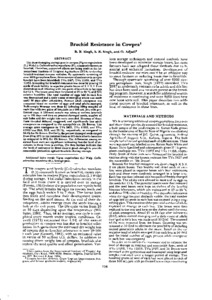| dc.description.abstract | The most damaging storage pest in cowpea [Vigna unguiculata (L.) Walp] is Callosobruchus maculatus (F.), commonly known bruchid. Therefore, concerted efforts are being made at the International Institute of Tropical Agriculture (IITA) to develop bruchid-resistant cowpea varieties. By systematic screening of over 8000 germplasm lines, three sources of resistance m cowpea bruchid have been identified: TVu 2027, TVu 11952, and TVu 11953. Screening for bruchid resistance was done by placing 10 seeds of each variety in separate plastic boxes of 5 ✕ 5 ✕ 2 cm dimensions and infesting with two pairs of bruchids to lay eggs for 15 h. The boxes were then incubated at 27 to 28 °C and 70% relative humidity. The total number of eggs laid in each box was determined and a daily count of emerging adults was made until 50 days after infestation. Percent adult emergence was computed based on number of eggs and total adults emerged. Bulk-sample bioassay was done by infesting 200-g samples of each line with two pairs of bruchids in a 500-mL jars with perforated caps. A 100-seed sample was taken at various intervals up to 180 days and data on percent damaged seeds, number of exit holes and dry weight loss were recorded. Bioassay of these lines revealed delayed, staggered, and significantly less adult emergence as compared to the susceptible cv. Ife Brown. The average adult emergence in TVu 2027, TVu 11952, and TVu 11953 was 26.6, 32.8, and 22.1%, respectively, as compared to 86.4% for Ife Brown. Similarly, the percent damaged seeds ranged from 25 t.o 26% in the resistant lines at 103 days after infestation as compared to 95% for Ife Brown. The differences among resistant lines were not significant indicating that the level of resistance in these lines is similar. The data further indicate that the level of resistance in these lines is good enough to provide reasonable protection against bruchids during storage. |

